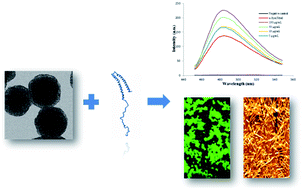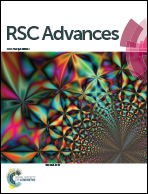The effect of mesoporous silica nanoparticle surface chemistry and concentration on the α-synuclein fibrillation
Abstract
The aggregation of an amyloid protein, α-synuclein (α-Syn), has been suggested as a potential cause of Parkinson's and several other neurodegenerative diseases. To explore the possibility of using nanoparticle-based therapeutic agents for the treatment of such diseases, we investigated the influence of surface chemistry and concentration of mesoporous silica nanoparticles (MSNPs) on the fibrillation of recombinant human α-Syn protein in the present work. Bare MSNPs as well as MSNPs of different surface functionalities, including 3-(2-aminoethyl amino) propyltrimethoxysilane (AAS), succinic anhydride (carboxyl), and polyethyleneimine (PEI) were prepared and characterized by electron microscopy, zeta potential measurement, Brunauer–Emmett–Teller (BET) isotherms, and FT-IR analyses. The process of α-Syn fibril formation was monitored by Thioflavin T (ThT) assay, atomic force microscopy (AFM) and fluorescence microscopy imaging. The conformation of α-Syn molecules in fibrillar forms and upon adsorption onto MSNPs was investigated by circular dichroism (CD) analysis, and an MTT assay was employed to evaluate the cytotoxicity effects of α-Syn fibrils on a PC12 cell line in the absence and presence of MSNPs. The synthesized MSNPs were spherical and monodisperse with an average size of 83 ± 6 nm. Our results showed that the fibril formation is reduced considerably in the presence of positively-charged MSNPs, i.e. AAS- and PEI-MSNPs, and is enhanced while treated with negatively-charged MSNPs, i.e. bare and carboxyl-MSNPs. Furthermore, it was also demonstrated that increasing the concentration of the MSNPs regardless of their surface chemistry results in greater effects on the fibril formation—promoting or inhibiting for negatively and positively-charged MSNPs respectively. Subsequently, the cytotoxicity of the formed aggregates was noticed to be significantly reduced in the presence of AAS- and PEI-MSNPs in comparison to that in the absence of these MSNPs. These results suggest that the electrostatic charges and concentration of MSNPs play important regulatory roles in the fibrillation process of α-Syn. Thus, the present study contributes towards the better understanding and control of protein fibrillation by nanoparticles which can lead to development of nanoparticle-mediated therapies.



 Please wait while we load your content...
Please wait while we load your content...